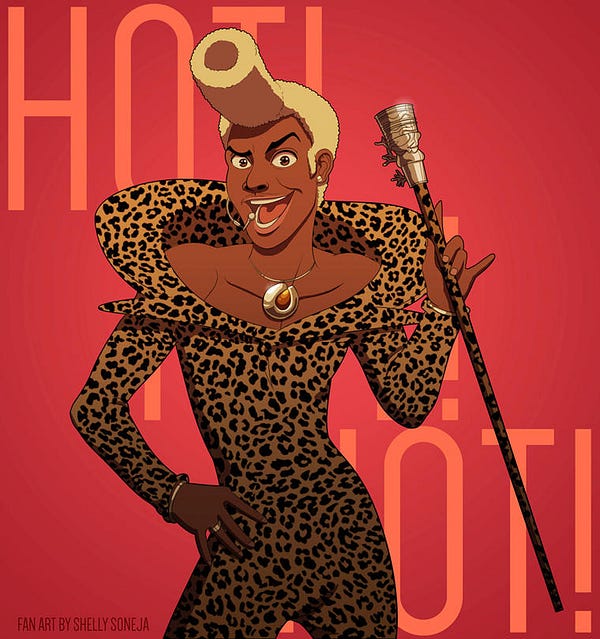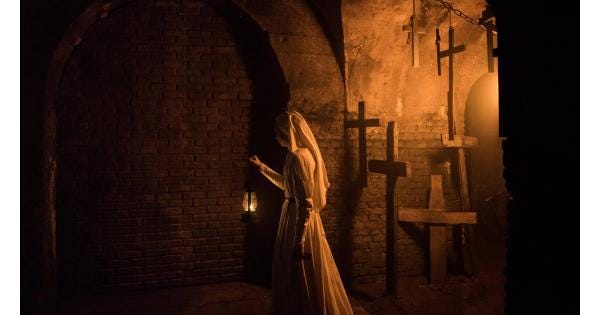Review: The Nun (2018)
The Nun has the dubious honor of featuring a monster who showed up to steal the spotlight from an earlier, impeccably titled movie, The Conjuring 2. And I don’t say that to be ironic. I honestly think we should stop being so coy with these titles. Everyone will just call it that no matter what it is branded unless the title is devilishly fun to say like Dream Warriors.
The Conjuring 2 is truly Jame Wan at the top of his already impressive game. Taking its cue from the “real haunting” of the Enfield Poltergeist, the movie had an interesting premise even without the demon Valak, in the form of a dentally challenged nun.
But Wan did two things impressively here:
- He held true to the location for the Enfield Poltergeist, choosing a cramped little tenement building in a rather unimpressive part of England. I found this particularly interesting because I didn’t even know I was exhausted by haunted houses not because they are hauntings, but because they are always in a Hill House style setting (that series being amazing is besides the point here!).
- Wan took that haunted house and managed to install a sympathetic old ghost. He did a bait and switch — using that trademark Wan misdirection and terrifying buildup of tension, he managed to make the viewer scared of the ghost in the house — then when the ghost is revealed, he just wants to move on. He’s tired. But he can’t due to this super ghost (the nun demon Valak).
I’m not alone here, right? These 2 things really make The Conjuring 2 stand out as exceptional. All a tired horror genre needs, really, is a fresh setting and a bit of a variation on the ol’ “there’s a violent death or some bullshit in this house, let’s research and be scared until the haunting escalates.”
In The Conjuring 2 that was Valak. This gnarly, wall floating, teeth-gnashing nun demon. That scene where the damn thing lines up with its own painting on the wall. It’s one of those moments you immediately back up to watch again. What a great character, what a great reveal. Wouldn’t that make a great movie?

Well.
I call it the Ruby Rhod Conundrum. It goes like this: Ruby Rhod was fucking awesome, maybe my favorite performance in Luc Besson’s superlative Fifth Element. It was like seeing a JoJo’s Bizarre Adventure character come to life. One time, discussing this movie, a friend mentioned they would love to see Ruby Rhod get his own film. Do you see the problem? We love Ruby Rhod, he chewed scenery, inserted levity and flavor into a movie that may have fallen into the average sci-fi adventure trappings if not for Chris Tucker’s performance. But by no means should he get his own film where he is the star. That’s too much of a good thing. It would get real annoying real fast. Ruby Rhod works as a foil to the subdued performance of Bruce Willis’s Korben Dallas (Multi-pass).
So, shit, I guess I should talk about The Nun, then. Where could I possibly be going? It pulled in 365.6 million USD at the box office, more than any of the other films in The Conjuring Franchise. It also has the lowest ratings at IMDB with a 5.4, Rotten Tomatoes with 26%, and Metacritic with 46%. Is this just a name recognition thing happening here? Even though it wasn’t directed by Wan, did its pedigree in the franchise make up for its apparent lack of quality?
I think at least a good portion of its success came from the character Valak, who is certainly positioned front and center in The Nun. No longer does she crouch behind the old shoulders of some sad-sack ghost in a Lay-Z-Boy. She was spooky and intriguing in The Conjuring 2. But, the Ruby Rhod Conundrum, right? People saw that awesome demon nun, saw that she was getting her own film and showed up. But then, to a good many viewers, the experience didn’t exactly deliver on its premise. What was a great foil to a tired, sympathetic ghost, didn’t amount to much more than more screen-time of the same gag from the first film.
I’m not the type of viewer to just off-handedly assign a number for how good a movie is, or to quickly state if it is something as subjective and meaningless as good or bad. Almost every film I have ever seen has redeeming qualities and moments that fell short of expectation. The Nun is no different. I want to look at this movie by examining its monster, the demon Valak; its strongest element, the setting; and its use of Catholicism.
To start, turns out Sister Valak is not complete bullshit. I mean, she’s bullshit like any other made up stuff is bullshit, but it looks like writer Gary Dauberman (co-writer of 2017’s IT) drew on some inspiration from a “real” demon. According to the Munich Manual of Demonic Magic, Valak (spelled Volach), is described as a “winged boy riding a two-headed dragon, attributed with the power of…” dowsing (a supernatural ability to find groundwater, gems, ore, or metals in the ground).
So they got the visuals a bit wrong, but in director Corin Hardy’s (director of The Hallow) defense, that shit sounds really silly looking. Why would a winged boy need to ride a two-headed dragon? Just fly kid.
But anyway, Valak is a thing apparently — described as a commander of demonic legions and “attributing him with the power to locate, summon, and control serpents.” There’s that dowsing I mentioned.
It’s a shame that doesn’t show up too much in The Nun. The dowsing and the serpents and what not. I always like it when screenwriters can work in some of this bat-shit superstition into their films. Makes for some great writing gymnastics. Otherwise you are just taking a name to make it sound real.
But I don’t want to count my boy Dauberman Pincher out. Seems to me Valak did in fact find something in the film. She found a Sunnydale style Hellmouth — an entrance into our world from the demonic one. So maybe that is what she dowsed. Can that be used as a common verb or can “dowsing” only be a gerund? I just learned about that word an hour ago so I’m going to allow it.
So if we have established Valak did in fact use that authentic demon power to find the entrance into our world through a hellmouth opened by bombing during World War II. It had been there forever I believe, but was simply exposed by the violence man does to each other. Which is my reading of the whole film, really.
This monastery was established on top of the hellmouth with good intentions. Its founders put the full weight of badass eternal prayer, devotion, and consecrated stones on top of that bad boy to protect our world from what lies beneath. But that evil started to influence those situated above it. It seeped up like, as the late, great Robert Jordan would put it, “bubbles of evil.” This isn’t explicitly stated, but I wonder if it either lead to, or was fed by perhaps some sort of secrets or violence in the church. Maybe all churches, but definitely that specific one. Violence towards the women there, perhaps by the priests or maybe from one another by keeping silent to the abuse. Maybe the use of ancient rituals meant to serve penance.
Cloistering silences that festered like the hellmouth did. It gained power, but still they kept it closed.
Sort of like a cycle of abuse and silence we see in the real catholic church. Outside of all this supernatural stuff. Nicole Winfield and Rodney Muhumuza at APnews.com, in their article “After Decades of Silence, Nuns Talk About Abuse by Priests,” speak to this buried-but-not-completely-forgotten silent tragedy befalling nuns over the years:
Sound familiar? Opened a great wound like… I don’t know, a hellmouth hidden in the bottom of an ancient church?
I don’t think I’m stretching when I say this might be a reason James Wan chose to have Valak take the form of a nun. Why Dauberman set this film in a Romanian monastary with a hidden, gaping wound being desperately guarded by frightened and exhausted nuns. Why it opens with one of them committing suicide. Why even in death they still haunt the church trying to keep the portal closed. These ghosts don’t attack Baby Farmiga and Sexy-Voice Priest, they help out. This was one of my favorite parts of The Nun. These terrified, tortured women don’t move on. They spend their afterlife trying to help fight back — which is how, it is hinted at, all of them must have died. Fighting the good fight.
This is also why the violence man can enact on another man is what starts all this. The bombing is what draws Valak in with its dowsing power. It is a finder of serpents, of the original serpent, Satan. It finds the Satan in man, and that is where it can enter the world.

And so, like the Conjuring 2, we have a unique setting. I have never seen a haunted house movie set in post-war Romanian dilapidated church guarding a gate to hell. The bells outside the graves for plague victims, the crumbling church itself, the hanging laundry moving like ghosts in the night, the beautiful lighting, suspect shadows, sound effects, music, and high-budget visual effects were all masterfully orchestrated. If for no other reason, horror fans should check out The Nun for the pure craft of it.
It does fall a little short on that second juh nuh say kwah [sic] I mentioned earlier. The Nun starts out as a haunting featuring a demon nun, ends with a big impressive battle featuring holy hand grenades filled with Jesus’s blood, and there isn’t much in between. There is an attempt at some depth of backstory with both Baby Farmiga and Sexy-Voice-Priest, but we never see that fully realized. Frenchie is a surprisingly likable cad, and I found myself shipping him with Baby Farmiga, but even he was played one note, if surprisingly heroic.
But the je ne sais quoi, as I mentioned, is missing. Which is a shame. Because all it needed was a end of second act twist, which all horror movies should really start trying. There is no WWII Nazi zombies or uncovering of priestly bad behavior or a realization for Sexy Priest. I got the feeling he felt bad about exorcising that kid to death, but that wasn’t explored really — other than it is another example of violence done by religious men in pursuit of doing something good. Possibly some secrets going on there too.
So what does this all amount to? Is this a scathing take down of Catholicism, an indictment on the unholiness of war, even fought in the name of God? I have no idea. I’m sure Dauberman, Wan, and Hardy weren’t exactly sure, but I think you’d have to be being pretty argumentative not to admit some of that does show up in this film. And is pretty interesting.
And those spooky hallways and cemeteries at night looks pretty fucking great.